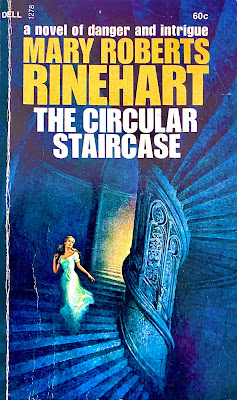Book Review: The Circular Staircase by Mary Roberts Rinehart
Miss Rachel Innes is a woman of independent means who raised her brother’s children Halsey and Gertrude after he and his wife passed away. They’re now in their early twenties, and have at long last persuaded their maiden aunt to rent a summer house out in the country, near the small town of Casanova. The owners of the house, the Andersons, have gone out to California for a while. But Miss Innes lets us know that this was anything but a restful vacation spot!

The first indication of trouble is that many of the servants have left, citing “unnatural goings-on.” There’s odd noises at night, with furniture and doors moving when there should be no one there. Even old faithful butler Thomas refuses to stay in the house past sundown, retreating to the housekeeper’s cottage nearby. And indeed, the first night Rachel and her personal maid Liddy hear noises and glimpse a mysterious figure that is vaguely woman-shaped.
The next day, Halsey and Gertrude arrive, along with Halsey’s friend (and secretly Gertrude’s fiancé) John Bailey. Mr. Bailey is a cashier at the Anderson Bank where the children’s money is deposited. All seems jolly enough until night falls and things turn spooky again. And at an ungodly dark hour of the morning, a man is found shot under the house’s unusual circular staircase.
The murder victim turns out to be Arthur Anderson, the black sheep son of the house’s owner. He was a rotter, and there’s more than one person who has a motive for killing him. In the excitement, it takes a while to be realized that both Halsey and John are missing. As is, it turns out, the Anderson Bank’s money! And then Rachel finds Halsey’s pistol buried in the flowerbed.
The police, led by detective Mr. Jamieson, arrive and investigate, but the case does not admit of an easy unraveling and soon other corpses appear.
This was Ms. Rinehart’s first bestseller, first appearing as a magazine serial in 1907 and in a collected edition in 1908. It established some of her frequent story beats: female protagonist, lots of extra little mysteries within the main plot, and “had I but known” narration. (See also my review of The Wall.)
Good: Miss Innes is a likable narrator, admittedly old-fashioned and not quite up with the young people’s notions and activities, but caring about her foster children and many of the people she employs or meets. She and Liddy banter and quarrel, but clearly can’t get along without each other.
There’s a lot of moving parts, made more mysterious by multiple people withholding information that really would have helped the police figure out who was innocent sooner. But it all comes together nicely by the end. The romance bits move the plot along rather than taking it over.
A fire, an abduction, and a claustrophobic moment when Rachel is trapped in a room with no light help keep things exciting.
Less good: Miss Innes is racist, in a “I’m sure she means well but it’s a bad look to modern readers” kind of way. She’s also pretty classist, and looks down her nose at tramps. (Like many people, she makes a distinction between the deserving and undeserving poor.)
Thomas, the African-American butler, has two major character traits, servile loyalty to his employer’s family, and deep superstition. These are both key to his function in the plot. (It’s noted though that he’s much better liked around town than either of the male Andersons.)
Overall: A fun old-fashioned mystery with a couple of sour bits from its place and time. It’s in the public domain, so should be easy to find.
The first movie made from the book has been lost, but Ms. Rinehart later cooperated in turning the book into a play, The Bat, which had a much more central role for the villain. The play was also a hit, and has had several movie adaptations, including this one with Vincent Price:

